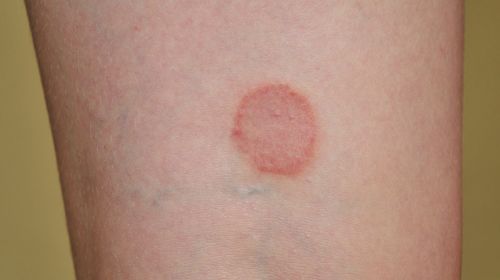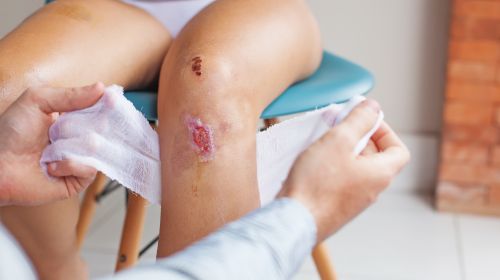An ulcus cruris, also known as an open leg, is a painful defect in the skin on the lower leg that is often difficult to heal. Read here why the skin becomes inflamed, what the first signs of a leg ulcer are and how it is treated.
- A leg ulcer can be very painful and oozing.
- © iStock.com/TPAP8228
Article content at a glance:
What is a leg ulcer?
A leg ulcer is a poorly healing ulcer or wound on the lower leg and is also known as an open leg. The cause is often an insufficient supply of the skin and tissue due to weak veins and circulatory disorders.
The first signs are changes in the skin, which over time can develop into an open, oozing and painful wound. Since the wound usually heals poorly, it is also referred to as chronic.
Leg ulcers often only appear with age. Most patients are over 75 years old. According to estimates, around one million people in Germany are affected by an open leg. Women more often than men.
An ulcer can also occur in other places on the body, for example in the stomach (ulcus ventriculi) or in the duodenum (ulcus duodeni).
Causes: How does an open leg develop?
A leg ulcer occurs when the skin and tissue are no longer adequately supplied with nutrients due to poor blood circulation. Then the skin loses its resilience and even a small injury can develop into a wound that heals poorly or not at all.
Depending on the cause of the circulatory disorder, a distinction is made between different forms of disease.
Most common form: venous leg ulcer (ulcus cruris venosum)
Around 80 percent of leg ulcers are caused by weak veins (chronic venous insufficiency). This is a venous disease in which the weak connective tissue in the vein walls no longer optimally supports the blood flow. The pathologically altered veins are unstable and widen or "ripple". As a result, the venous valves can no longer close properly and transport the blood towards the heart.
Instead, it sags and builds up in the calves, which can lead to varicose veins. Fluid builds up in the tissue and causes swelling (edema). The resulting pressure makes the blood flow to the surrounding tissue more difficult, which is why it is no longer adequately supplied with oxygen and nutrients.
The poor blood circulation changes the skin and connective tissue: the upper layer of skin becomes thinner, eczema occurs more frequently, the skin turns brown. If the tissue is particularly badly damaged by the undersupply, the skin cells die (necrosis) and a wound occurs. An ulcer that then develops is known as a venous leg ulcer (venous leg ulcer).
Arterial leg ulcer (Ulcus cruris arteriosum)
The arterial leg ulcer is the second most common form of the open leg with ten percent. This is caused by deposits in the arteries, which ultimately lead to the occlusion of the vessels (peripheral arterial occlusive disease). Circulatory disorders in the legs occur. Skin and tissue are no longer adequately supplied with oxygen-rich blood. If the skin is undersupplied, ulcers develop.
Other causes of leg ulcers
In some cases venous and arterial causes can occur at the same time. This mixed form is known as a mixed leg ulcer. In addition, other causes can promote the development of a leg ulcer.
This includes:
Symptoms: what does an open leg look like?
An open leg shows up in a number of signs. If these are recognized and treated in good time, the development of an ulcer can be prevented.
Early warning signs of a venous leg ulcer:
Long-standing swelling on the legs
Sense of tension in the calves
Formation of thrombosis
Water retention and edema in the ankle area
Brownish congestion spots on the inner and outer ankles or on the inside of the lower legs
Little pain
Early warning signs of an arterial leg ulcer:
Feet and legs are cool and pale due to arterial occlusion
Severe pain in the legs, especially when moving and walking long distances
Skin changes, especially on the back of the foot, the edges of the foot and the outer sides of the lower legs
If wound formation occurs, venous ulcers show up with an irregular wound edge and a moderate wound depth. Arterial leg ulcers, on the other hand, are very deep and look like they have been punched out. The ulcers can widen over time. They are also very painful and oozing. In the advanced stage, an unpleasant odor can also develop.
Which treatment is useful for leg ulcers?
Treating an open leg is often very tedious, especially if the ulcer has been around for a long time. Basically: the sooner an open leg is treated, the better the process. This also applies to small wounds that do not heal on their own.
The primary goal of treatment is wound care for the open leg and pain relief. The wound treatment for the various forms of disease is the same and should be carried out regularly by a doctor. This includes the following steps:
Wound cleaning: The wound is first cleaned. The medical term for this is wound toilet. This involves removing dead and damaged tissue and, if necessary, rinsing the wound with an antiseptic solution.
Wound care: The ulcer is then treated with special wound dressings. So-called hydrocolloid dressings are used when the wound does not wet a lot. This dressing ensures a moist wound environment in order to stimulate the regeneration of the tissue. On the other hand, foam or alginate dressings are used for more exuding wounds, which also have a beneficial effect on the wound climate.
Because leg ulcers cause severe pain, pain relievers are often needed to treat them.
If a wound is so large that it no longer closes on its own, a skin graft can be an alternative. This involves connecting your own skin from another part of the body or an artificially produced piece of skin to the healthy skin on the edge of the wound. The healthy edges of the skin grow together within a few days.
Treat not only ulcers, but also the underlying disease of leg ulcers
In order for the wound treatment to be successful, the underlying disease must be cured in parallel.
With a venous leg ulcer, it is necessary to stimulate the blood flow in the veins and reduce the swelling in the lower leg. This is achieved with compression therapy, for example with special compression bandages or stockings. If there are varicose veins, they will be removed. With regular exercise, those affected can also stimulate blood flow and reduce congestion.
In the case of an arterial leg ulcer, for example, a bypass may be necessary. Those affected must also reduce possible risk factors and greatly increase their physical activity.
Are there home remedies for an open leg?
Open leg treatment belongs in the professional hands of a doctor or wound therapist. Home remedies such as ointments, chamomile tinctures or honey can irritate the wound even more and should therefore not be used. If you want to do something yourself, you can support wound healing with certain behaviors:
If you have a venous leg ulcer, put your legs up regularly and do not cross over when sitting. Basically a lot of moving and often switching between standing and sitting while doing the same.
If you have an arterial leg ulcer, keep your legs low and move around a lot.
Course of the disease and prognosis in ulcus crusris
With consistent and early treatment, an open leg heals completely within a few months in most of those affected. A venous leg ulcer has a better chance of healing than an arterial ulcer. However, venous leg ulcers recur more often. Certain behaviors, such as raising your legs or not crossing them, as well as fitted compression stockings, can reduce the risk of relapse.
On the other hand, if open legs are not treated quickly, bacteria can penetrate deep tissue layers and cause an infection. This can require major surgery or even an amputation.
Recognize and prevent risk factors for an open leg
There are risk factors that promote the development of peripheral arterial occlusive disease (PAD) and thus the development of an arterial leg ulcer. These include diabetes mellitus, high blood lipids, obesity, smoking and high blood pressure. The risk factors for weak veins are mainly hereditary and hormonal.
But obesity, excessive alcohol consumption, warmth, high footwear and predominantly sitting or standing activity can negatively affect vein health.
To prevent an open leg, it is therefore recommended:
Exercise regularly and as often as possible
Reduce excess weight
Stop smoking
Eat a healthy and balanced diet
In addition, it is important:
Check your legs and feet regularly
Wear soft and suitable footwear
Avoid injuries and pressure points
Do not scratch the affected skin if mosquito bites or itching


